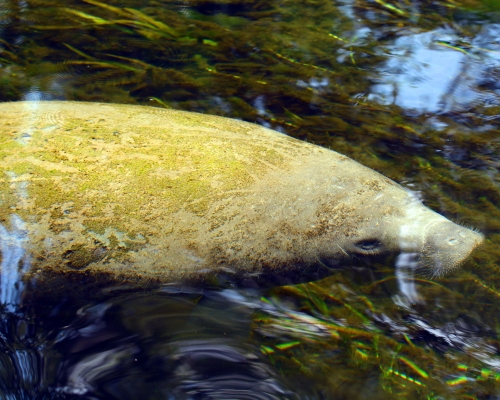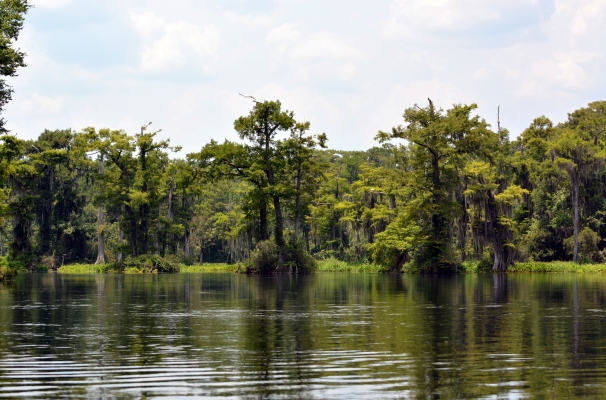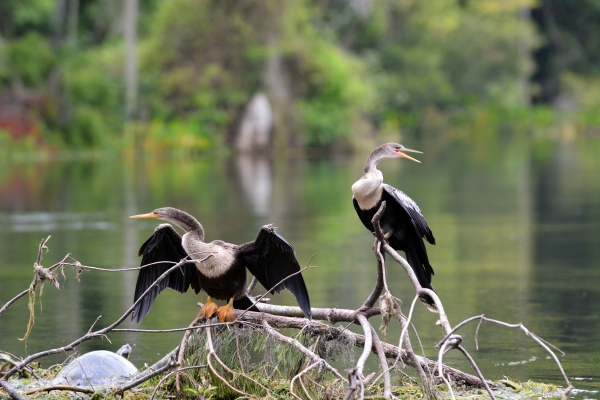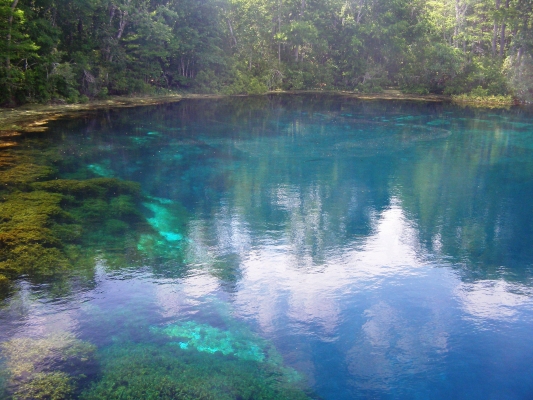Wakulla Springs
Wakulla Springs is a first-magnitude spring, which means it discharges 64.6 million gallons per day or more.
Overview
Described as the gem of northwest Florida, Wakulla Spring is one of 31 first magnitude springs in the state. The spring has an average flow of approximately 623 cubic feet per second, which translates to roughly 400 million gallons of water per day. Wakulla Spring is located within Edward Ball Wakulla Springs State Park. According to the park’s website, Wakulla means “river of the crying bird” or “strange and mysterious waters.” Archaeological evidence suggests that humans have occupied Wakulla Spring for nearly 15,000 years.
The spring vent is located beneath a limestone ledge near the diving tower on the south side of the large spring pool. The vent extends into a massive network of caverns and tunnels that have been extensively mapped by Woodville Karst Plain Project divers. At its discharge point, the spring vent is approximately 180 feet below land surface at the southern end of the spring pool. At times of clearest water, the ledge above the cavern opening is visible from the nearby dive tower. The ledge is approximately 25 feet below the water surface.
In the late 1990’s, the invasive exotic aquatic plant hydrilla took hold in the spring and continues to be an extreme nuisance despite repeated treatment. A portion of the spring pool is operated as a swimming area and guided river boat tours are available to explore this natural wonder. Because water temperatures are nearly constant year round, Wakulla Spring provides a winter refuge for the Florida manatee.
Unique Features
Fresh water discharging from Wakulla Spring comprises the majority of the flow in the Wakulla River. The relatively warm water discharge from Wakulla Spring provides a winter thermal refuge for the Florida manatee. The Wakulla River provides water to the St. Marks River which, in turn, discharges fresh water into the Apalachee Bay estuary, an important nursery area for the endangered Kemp’s Ridley turtle and habitat for juvenile and adult fish, shrimp, crabs, and oysters. Wakulla River, Apalachee Bay, and most of the St. Marks River below the river rise at Natural Bridge are designated as Outstanding Florida Waters and protected from activities that would degrade water quality. A large portion of the Big Bend Seagrasses Aquatic Preserve is within Apalachee Bay. The Preserve is the largest expanse of nearly pristine seagrass and salt marsh in Florida and is an important nursery area for fisheries in the Gulf Coast. Water from Wakulla Spring and the St. Marks River flows through and influences St. Marks Wildlife Refuge, which provides wintering grounds, nesting areas, and habitat for over 300 species of birds. Some of the endangered or threatened species that nest in the refuge include the Southern Bald Eagle, Least Tern, and Red-cockaded Woodpecker. Wakulla Spring provides vital fresh water to the river and bay and supports the substantial value of these recreationally and commercially important areas.
Wakulla Spring and the state park are also an important recreation area. The park offers hiking trails, geocaching, swimming, picnic facilities, boat tours, a historic lodge, and restaurant. Open water diving is allowed at Cherokee Sink in the park and cave diving is permitted at Emerald and Clearcut sinks.
Projects
FY 2017-2018
District awarded more than $14 million for springs projects
FY 2016-2017
District adopts 2016-17 budget focused on springs, water resource protection
District awarded $15.3 million for springs projects
FY 2015-2016
Springs restoration continues with $17.8 million investment in northwest Florida
District adopts budget focused on springs, water resource protection
FY 2014-2015
NWFWMD Budget Continues Focus on Water Resource Protection
Proposed Springs Funding to Benefit Environment and Communities of Northwest Florida





